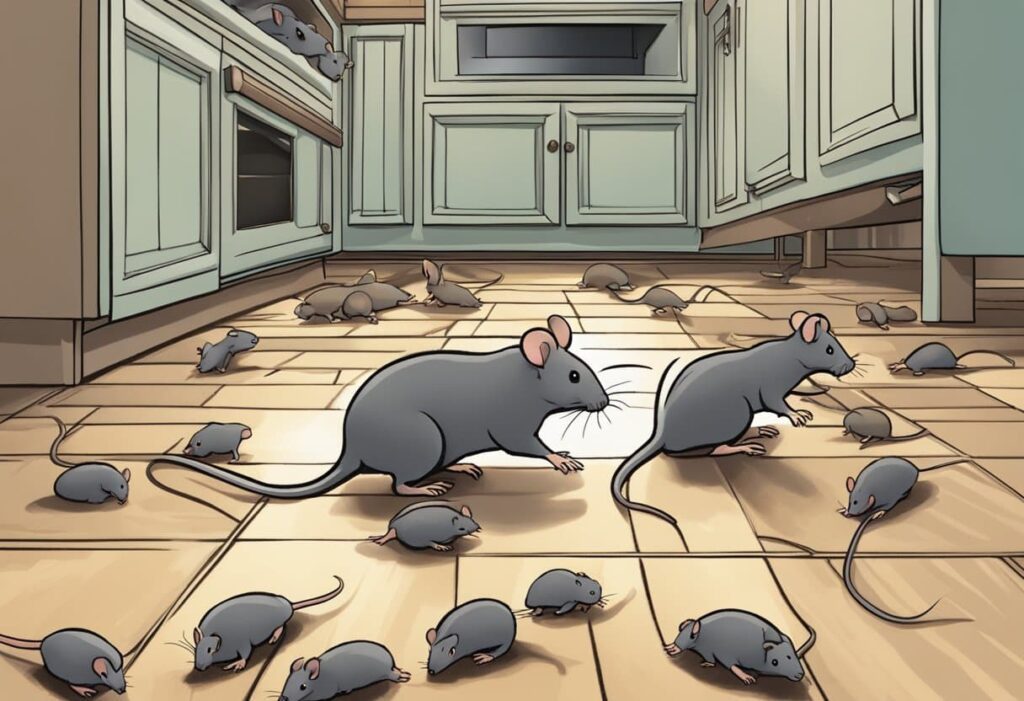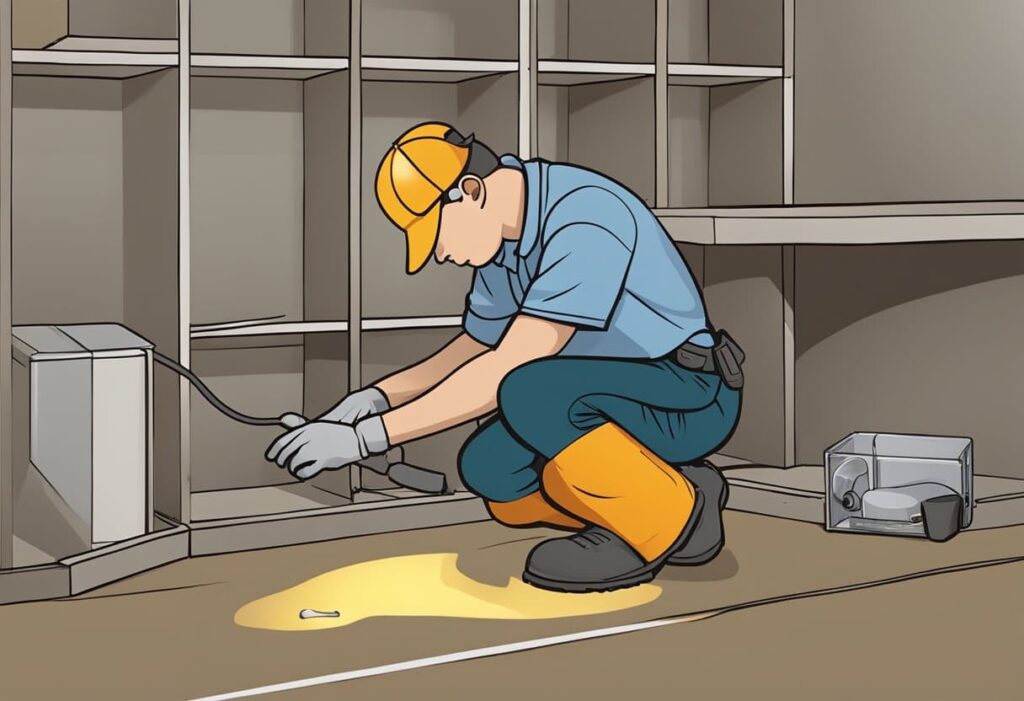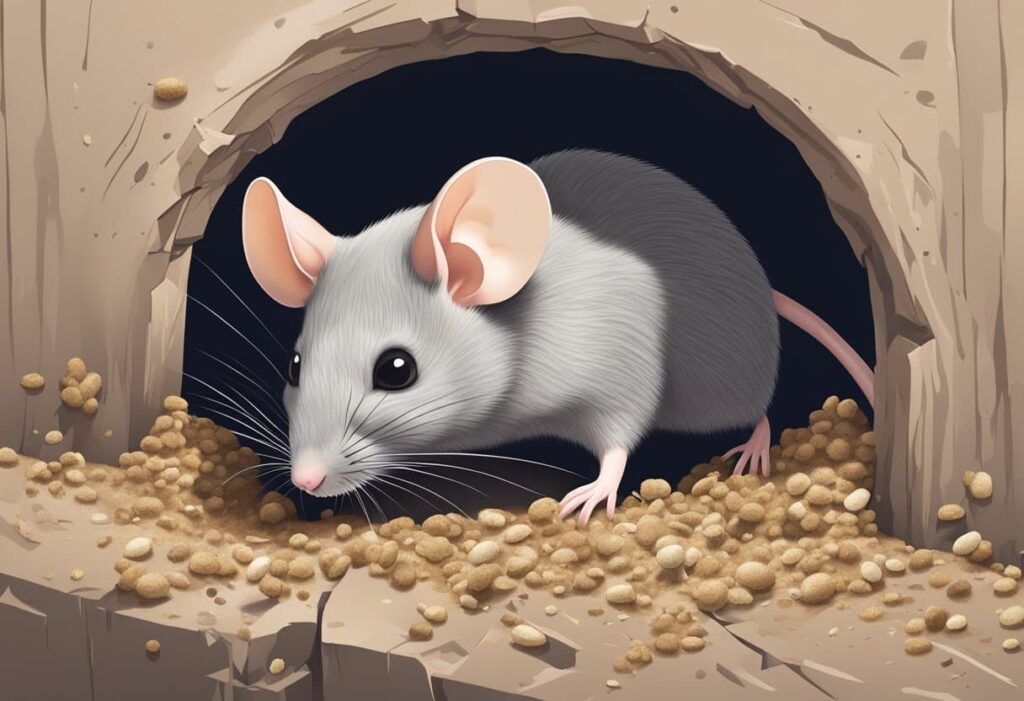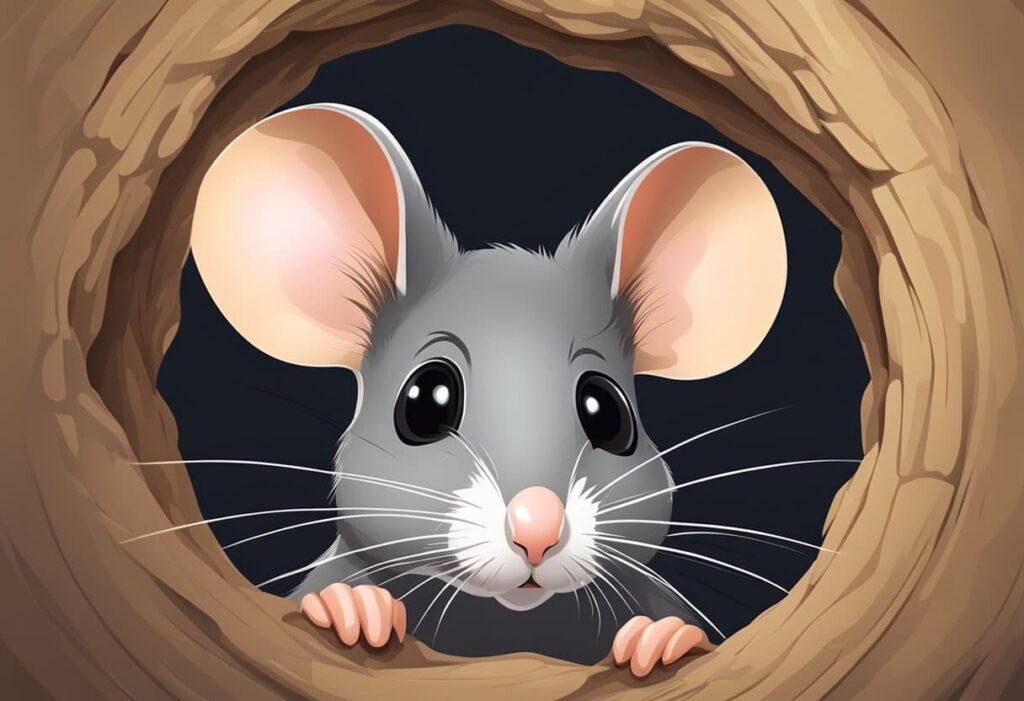Mice make distinct sounds that can help you identify them in your home. What do mice sound like? These critters communicate through squeaks, scratches, and scurrying noises that are often heard during the quiet nighttime hours. Mice typically produce high-pitched squeaks, rapid scratching sounds in walls or ceilings, and light pitter-patter noises as they move around your house.

Their vocalizations range from ultrasonic chirps that humans can’t hear to audible squeaks that sound like tiny whistles. The scratching noises come from their constant gnawing habit, as mice must chew on hard surfaces to keep their ever-growing teeth filed down.
At night, you might hear mice rustling through insulation or scurrying across attic spaces. These sounds often intensify when multiple mice establish a nest in your home, creating a chorus of unwanted pest activity that disrupts your peace and signals a potential infestation.
What Do Mice Sound Like? Common Noises Made by Mice
Mice create several distinctive sounds that can help identify an infestation in your home. Knowing these noises is the first step to addressing a potential mouse problem.
Scratching: Often Heard Inside Walls, Ceilings, or Behind Baseboards
The scratching sounds mice make are quite distinctive. These noises typically occur at night when mice are most active. The scratching comes from their claws as they climb up walls, across ceiling joists, or behind baseboards.
Many homeowners describe the sound as light but persistent. It’s often rhythmic, following the pattern of small paws moving across surfaces.
The intensity of scratching can vary based on:
- The surface material (drywall, wood, insulation)
- The number of mice present
- How close are they to your living space
If you hear these sounds primarily after dark, especially in quiet parts of the house, mice are likely the culprits.
Gnawing: Mice Chewing on Wood, Wires, or Plastic
Mice have front teeth that never stop growing. This biological fact drives them to gnaw constantly. The gnawing sound is often described as a persistent grinding or crunching noise.
Common targets for mouse gnawing include:
- Wooden structures
- Electrical wiring (a serious fire hazard)
- Plastic containers or pipes
- Cardboard boxes
This chewing noise tends to be more pronounced than scratching. It often occurs in bursts of 10-30 seconds as mice work to create holes or access food sources.
The sound has a distinct texture, like sandpaper against wood or plastic, and may be accompanied by falling debris if they’re working on ceiling materials.
Scurrying: Fast, Light Footsteps Especially in Attics or Crawl Spaces
Mice move quickly with a distinctive scurrying sound. These rapid, light footsteps often sound like a soft patter across surfaces. A mouse can cover several feet in seconds, creating brief bursts of movement noise.
In attics, the scurrying becomes more noticeable as mice run across ceiling materials. Many homeowners report hearing these sounds just after dusk or before dawn when mice begin or end their nightly activities.
The weight of a house mouse (about 20 grams) creates much lighter footsteps than rats or squirrels. This difference helps pest experts identify the specific rodent problem.
The scurrying pattern often follows distinct paths as mice use the same routes repeatedly. They prefer to travel along walls or beams rather than in open spaces.
Chirping or Squeaking: High-Pitched Vocalizations Used for Communication
Mice are surprisingly vocal creatures. Their squeaks and chirps serve as a complex communication system. These high-pitched vocalizations typically range from 1,000 to 20,000 Hz, with some ultrasonic calls beyond human hearing.
Mice squeak for several reasons:
- Mating calls: Males sing complex ultrasonic songs to attract females
- Warning signals: Quick, sharp squeaks alert others to danger
- Territorial disputes: Aggressive vocalizations during confrontations
- Mother-pup communication: Specific calls between mothers and babies
The audible squeaks humans hear represent only part of mice’s communication. Most of their vocalizations occur in ultrasonic ranges. Special equipment can detect these sounds during professional pest inspections.
Baby mice make particularly loud squeaking sounds when separated from their mothers.
How Sounds Differ from Other Pests
Mouse sounds have distinct characteristics that separate them from other household pests. Rats produce deeper, heavier footsteps and louder gnawing due to their larger size. Their vocalizations also tend to be lower in pitch.
Squirrels create much louder running and jumping sounds, often during daylight hours. Their movements include distinct thumps that mice don’t produce.
Insects like carpenter ants make subtle clicking sounds when inside wood, while termites create soft tapping noises. These are much quieter and more rhythmic than mouse activities.
Time patterns also help identify mice:
- Primarily nocturnal (most active from dusk to dawn)
- Brief bursts of activity followed by quiet periods
- Increased sound during breeding seasons (spring and fall)
The location of sounds offers additional clues, as mice prefer enclosed spaces near food sources, while other pests have different habitat preferences.
When and Where You’re Most Likely to Hear Mice

Mice make themselves known through distinctive sounds at specific times and in certain areas of your home. Their patterns follow natural behaviors that can help you identify where they’re hiding.
Nighttime Activity: Mice Are Nocturnal—Why This Matters
Mice operate primarily between dusk and dawn when houses are quiet and still. Their nocturnal nature evolved as a survival mechanism to avoid predators. During nighttime hours, you’ll hear the most mouse activity, typically between midnight and 4 AM, when human activity is minimal.
These rodents have poor eyesight but excellent hearing and sense of smell. They navigate effectively in darkness using their whiskers and body hair to sense objects around them.
The silence ofthe night makes mouse sounds more noticeable. If you’re hearing scratching, gnawing or scurrying when trying to sleep, it’s almost certainly mice at work. Many homeowners first discover infestations during sleepless nights when household noise is absent.
Common Locations: Walls, Attics, Basements, Vents, Under Cabinets
Mice create sound pathways throughout homes. Wall voids serve as highways for mice, with the hollow space amplifying their movements. Listen for scratching and scurrying inside drywall or behind baseboards.
Attics provide ideal nesting spots due to insulation and minimal human disturbance. Basement rafters and floor joists offer perfect runways for mice seeking warmth and shelter.
Most Common Sound Locations:
- Inside wall voids
- Above ceiling panels
- Behind kitchen appliances
- Inside ventilation ducts
- Under bathroom and kitchen cabinets
- Around pipes and utility entrances
Mice prefer running along edges rather than open spaces. This habit makes corners, baseboards, and where walls meet floors prime listening spots for detecting their movements.
Seasonal Trends: Fall and Winter Increases in Indoor Nesting
Mouse invasions spike dramatically when outdoor temperatures drop. Fall brings a natural migration as mice seek warm shelter before winter. October through February marks peak mouse season in Colorado.
The first cold snap typically triggers mass movement indoors. Mice need only a pencil-sized opening (roughly 1/4 inch) to squeeze into homes. Once inside, they begin building nests and searching for food sources.
Winter intensifies indoor activity as outdoor food becomes scarce. Mice don’t hibernate and remain active year-round, requiring constant feeding.
Sound activity often increases during cold snaps. Mice gather nesting materials by shredding paper, fabric, and insulation. This gathering creates more noise as they work to build warm nests to survive winter temperatures.
Other Signs of a Mouse Infestation
Mice leave behind various telltale clues beyond just the sounds they make. These signs can help confirm an infestation even when the rodents remain hidden from view.
Droppings (Small, Pellet-Like)
Mouse droppings are one of the most obvious signs of an infestation. Fresh droppings appear black and shiny, while older ones turn gray and crumbly. These pellets measure about 1/8 to 1/4 inch long and resemble dark rice grains.
Mice typically leave 50-75 droppings per day. They’re commonly found near food sources, along baseboards, inside cabinets, and behind appliances.
When cleaning rodent droppings, always use gloves and disinfectant. Never sweep or vacuum them, as this can release harmful particles into the air. Instead, spray with disinfectant, wait 5 minutes, then wipe up with paper towels.
The location of droppings often reveals travel routes and nesting areas. Heavy concentrations indicate areas of high mouse activity.
Grease Marks Along Baseboards
Mice have oils in their fur that leave dark, greasy marks on surfaces they frequently travel. These smudges appear along baseboards, walls, and entry points.
The marks darken over time as mice repeatedly use the same paths. Fresh marks may feel slightly oily to the touch.
These “rub marks” often form near entry holes or tight spaces where mice squeeze through. The size of the mark can indicate the level of traffic—wider, darker marks suggest higher activity.
Look for these marks at floor level, especially where walls meet floors. They’re particularly visible on light-colored surfaces and often form distinctive patterns along corners.
Gnawed Food Packaging or Structural Materials
Mice constantly gnaw to keep their ever-growing incisor teeth trimmed. They’ll chew through food containers, cardboard boxes, and even structural materials.
Fresh gnaw marks appear light-colored and rough, while older ones darken over time. The tooth marks typically measure about 1/16 inch long.
Common targets include:
- Cereal boxes and paper packaging
- Plastic food containers
- Furniture corners and wooden structures
- Electrical wiring (a significant fire hazard)
- PVC pipes and insulation
The pattern of gnawing can reveal the size of the infestation. Extensive damage suggests multiple mice or prolonged activity.
Nesting Materials (Shredded Paper, Insulation)
Mice build nests from soft, readily available materials they shred into small pieces. Finding scattered bits of torn paper, fabric, or insulation indicates nesting activity nearby.
Typical nesting materials include:
- Shredded paper and cardboard
- Fabric scraps and string
- Insulation from walls or appliances
- Dried plant material and grass
- Hair (including pet fur)
Nests are usually found in quiet, hidden areas like wall voids, cabinet backs, and appliance insulation. They’re typically round, measuring 4-6 inches in diameter.
The freshness of nesting materials indicates recent activity. New nests contain clean, recently gathered materials, while older nests appear dusty and compressed.
Unusual Pet Behavior (Dogs/Cats Focusing on Specific Areas)
Pets often detect mice long before humans do. Their heightened senses pick up on mouse presence through smell, sound, and movement.
Dogs may exhibit behaviors like:
- Persistent sniffing or pawing at specific walls or corners
- Sudden fixation on seemingly empty spaces
- Unusual alertness at night when mice are active
- Barking at cabinets or appliances
Cats demonstrate their awareness through:
- Staring intently at walls or ceilings
- Pouncing at invisible targets
- Sitting motionless while focused on a particular spot
- Increased prowling behavior, especially at dusk and dawn
These behavioral changes often pinpoint exactly where mice are hiding. Pay special attention to areas where pets repeatedly return or show heightened interest.
Mouse Sounds vs. House Noises: How to Tell the Difference
Identifying mouse sounds amidst normal house noises can be challenging for homeowners. The key differences lie in timing, pattern, and location of the sounds you hear.
Distinguishing Between Normal Home Settling vs. Rodent Activity
Houses naturally make noises as materials expand and contract with temperature changes. These settling sounds typically occur during temperature transitions at dawn or dusk. They sound like occasional creaks, pops, or single thumps.
Mouse activity, however, follows different patterns. Mice create a light pitter-patter sound that resembles tiny footsteps. These sounds often occur at night when mice are most active.
Location matters too. House settling noises usually come from structural areas like joists or walls. Mouse noises commonly originate from:
- Inside walls
- Between floors
- Along baseboards
- In attics or crawl spaces
Key difference: House noises are random and isolated, while mouse sounds tend to follow paths or trails.
Sounds That Suggest a Larger Infestation
Certain sounds indicate you’re dealing with more than just one or two mice. A chorus of squeaking, especially during quiet hours, suggests multiple mice communicating.
Scratching noises coming from multiple areas simultaneously point to an established colony. Frequent chewing or gnawing sounds indicate mice creating nests or pathways.
Warning signs of a serious infestation:
- Constant activity throughout the night
- Sounds are becoming louder or more frequent over time
- Noises coming from multiple locations
- Daytime activity (mice typically avoid daylight unless competition for food is high)
The intensity and frequency of these sounds directly correlate with the size of the infestation. More noise generally means more mice.
Why Intermittent Noises May Still Indicate Mice
Don’t be fooled by sporadic sounds. Mice are naturally cautious creatures and may freeze when they sense danger. This results in stop-and-go movement patterns.
A silent period doesn’t mean the mice have left. They may be:
- Resting in their nests
- Feeding in a stationary position
- Remaining still after being startled
Seasonal factors also influence mouse activity. Sounds often increase in fall and winter as mice seek warmth indoors. Even if you hear noises only occasionally, this could still indicate a developing problem.
Remember: Mice reproduce rapidly. A few intermittent sounds today could become a constant chorus within weeks if left unchecked.
Address Common Homeowner Confusion
Many homeowners mistake mouse sounds for other household issues. HVAC systems cycling on and off can produce clicking sounds similar to mice chewing. Water pipes may create tapping noises that resemble light mouse steps.
Appliances with motors or fans sometimes generate vibrations that travel through walls, mimicking rodent activity. Electronic devices can emit high-pitched frequencies that sound like distant mouse squeaks.
Simple test: Mouse sounds usually stop briefly when you make a loud noise or vibration. Mechanical sounds typically continue uninterrupted.
Time of day provides another clue. Mechanical noises happen throughout the day, while mouse activity peaks between dusk and dawn. When in doubt, professional pest inspectors can use specialized equipment to pinpoint the exact source of mysterious sounds.
What to Do if You Hear Mice in Your Home
Finding mice in your home requires quick action to prevent a small problem from becoming a major infestation. The sooner you address suspicious noises, the easier and less expensive the solution will be.
Don’t Ignore Persistent or Increasing Noise
Mouse noises typically intensify at night when these creatures become most active. Pay special attention to scratching, scurrying, or squeaking sounds coming from walls, ceilings, or dark corners.
These sounds might start in one area but gradually spread throughout your home as mice establish nests and travel paths. A single mouse can quickly become dozens within weeks.
Keep a log of when and where you hear noises. This information helps pest control professionals identify entry points and high-activity areas during inspection.
Remember that seasonal changes often drive mice indoors. More noise in fall and winter months strongly indicates mice seeking shelter from cold weather.
Avoid Using DIY Poisons or Traps Without Proper Placement
Store-bought mouse traps can be effective when used correctly, but improper placement wastes time and money. Place traps along walls where mice typically travel rather than in open spaces.
Effective trap placement locations:
- Behind appliances
- Inside cabinets
- Along baseboards
- Near visible droppings
- Near gnawed materials
Avoid poison baits in homes with children or pets. Poisoned mice often die inside walls, creating foul odors and attracting other pests.
Consider humane catch-and-release traps if you prefer not to kill mice. However, release captured mice at least one mile from your home to prevent their return.
Peanut butter, chocolate, and seeds make more effective bait than cheese, contrary to popular belief.
Importance of Prompt Professional Inspection
Professional pest control technicians identify entry points that homeowners often miss. These can include tiny cracks in foundations, gaps around pipes, and loose weatherstripping.
Technicians use specialized equipment to detect mice in hard-to-reach areas like attics, crawl spaces, and inside walls. They also identify nest locations that require removal.
A comprehensive inspection determines the size of the infestation. One or two mice require different approaches than a full-blown infestation.
Professional treatments target the specific mouse species in your home. Deer mice, house mice, and field mice each have different behaviors and require tailored removal strategies.
Early intervention prevents secondary infestations of insects like fleas and ticks that mice often carry.
How Mice Can Cause Structural Damage and Health Risks
Mice constantly gnaw to keep their ever-growing teeth filed down. They chew through wood, plastic, drywall, and even electrical wiring – creating fire hazards throughout homes.
Mouse droppings contaminate surfaces and can spread diseases like hantavirus, salmonellosis, and lymphocytic choriomeningitis. These pathogens can affect humans through direct contact or airborne particles.
Mice trigger allergic reactions and asthma attacks in sensitive individuals. Their fur, urine, and droppings contain powerful allergens that circulate through home ventilation systems.
Food contamination occurs quickly in pantries and cabinets. Mice urinate constantly while moving, potentially contaminating far more food than they actually eat.
Insulation damage from nesting mice reduces energy efficiency and increases utility bills. Replacing contaminated insulation often becomes necessary after removing an infestation.
How Solatera Pest Control Identifies and Eliminates Mice

Solatera Pest Control uses advanced techniques to detect and remove mice from homes and businesses in Denver. Their team combines thorough inspections with targeted removal methods to ensure complete elimination of mouse infestations.
Comprehensive Inspection Services
Solatera’s technicians begin with a detailed property assessment. They look for subtle signs most homeowners miss, such as tiny grease marks along baseboards or microscopic droppings in hidden corners.
Technicians use specialized equipment including:
- Ultraviolet light detectors that reveal urine trails
- Thermal imaging cameras to spot nests inside walls
- Moisture meters to identify damaged areas
Every inspection includes checking entry points as small as a dime—the only space a mouse needs to enter a building. Solatera documents all findings with photos to show clients exactly where problems exist.
Unlike competitors, they inspect attics, crawl spaces, and utility areas often overlooked by less thorough services.
Safe and Targeted Removal Strategies
Solatera employs a multi-pronged approach to mouse removal that prioritizes effectiveness and safety.
Their methods include:
- Strategic trap placement based on mouse travel patterns
- Tamper-resistant bait stations placed only where children and pets cannot access
- Non-toxic options for families concerned about chemicals
Technicians monitor all trapping systems during follow-up visits. This ensures continuous effectiveness and prevents the unpleasant situation of forgotten traps.
Solatera uses different strategies for different situations. Restaurants require food-safe methods, while homes with small children need extra safety precautions. This customized approach sets them apart from companies that use one-size-fits-all solutions.
Ongoing Prevention
After eliminating the immediate mouse problem, Solatera focuses on prevention strategies.
The prevention plan typically includes:
- Sealing entry points with steel wool and caulk
- Installing door sweeps on exterior doors
- Repairing damaged vents and screens
Technicians educate homeowners about proper food storage and waste management. These simple habits dramatically reduce the chance of future infestations.
For commercial clients, Solatera creates maintenance schedules with regular inspections. These proactive measures help businesses avoid health code violations and protect their reputation.
Local Expertise
Solatera’s team understands the unique challenges of mouse control in Denver’s climate and building styles.
Their local knowledge includes:
- Mouse behavior during Colorado’s seasonal changes
- Common entry points in Denver’s varied architectural styles
- City-specific regulations regarding pest control
This expertise allows them to outperform national chains that use standardized approaches. Solatera technicians receive training on the specific mouse species common to the Front Range region.
Many clients switch to Solatera after experiencing disappointing results with other services like Critter Control. The company’s deep understanding of local conditions makes their solutions more effective and longer-lasting.
Call to Action: Don’t Wait—Schedule a Rodent Inspection Today

If you’ve heard mysterious scratching or squeaking sounds in your home, it’s time to take action. Mice infestations quickly grow from a minor nuisance to a serious health and property risk.
Encourage Readers to Act Early to Prevent Damage
Most homeowners wait too long before calling professionals about mice problems. By the time squeaking sounds become noticeable, a significant infestation may already exist.
Early intervention saves money. A single female mouse can produce up to 60 offspring per year, turning a small problem into a major infestation in weeks.
Mice damage increases exponentially over time:
- First week: Minor gnawing on food packaging
- First month: Electrical wire damage begins
- 3+ months: Structural damage, contaminated insulation, fire hazards
Waiting even one extra week allows mice to establish nesting areas and reproduce. Solatera Pest Control technicians find that homes with early intervention require 60% less treatment time and resources.
Offer a Free or Discounted Inspection If Applicable
Solatera Pest Control offers free initial rodent inspections for Denver residents. This thorough assessment includes:
- Examination of attics, basements, and crawlspaces
- Identification of entry points as small as 1/4 inch
- Detection of nesting materials and droppings
- Assessment of potential damage to wiring and structures
Our technicians use specialized equipment to detect rodent activity in hard-to-reach areas. Thermal imaging identifies nests hidden in walls.
First-time customers receive 15% off their initial treatment plan. Senior citizens and military personnel qualify for additional discounts. The inspection takes just 30-45 minutes, and our technicians respect your time with punctual service.
CTA Button: “Request a Free Rodent Assessment”
Getting professional help is simple. Click the button below to schedule your free inspection with one of Solatera’s certified rodent specialists.
[REQUEST A FREE RODENT ASSESSMENT]
Same-week appointments are available. Evening and weekend slots accommodate busy schedules.
Our assessment comes with no obligation – just expert advice and peace of mind. After your inspection, you’ll receive a detailed report and personalized treatment recommendations from Denver’s most trusted pest control experts.
Don’t let those mouse sounds keep you up at night. Take the first step toward a rodent-free home today.
Frequently Asked Questions

Mice create various sounds that indicate their presence in homes and buildings. These noises differ depending on the time of day, mouse activity, and their location within structures.
What are the common sounds associated with mice activity inside a home?
Mice typically make scratching, scurrying, and gnawing sounds as they move around homes. The scratching noise comes from their claws on surfaces like wood or drywall.
Squeaking and chirping sounds may also be heard, especially when mice communicate with each other. Gnawing sounds occur when mice chew on wires, wood, or other materials.
These sounds are often more noticeable at night when homes are quiet and mice are most active.
How can you distinguish mouse sounds at night from other nocturnal noises?
Mouse sounds tend to be light, quick, and repetitive. Their movement creates a pattern of short bursts rather than continuous noise.
Unlike larger pests such as rats or squirrels, mice produce softer sounds. Their scurrying has a distinctive pitter-patter quality that’s lighter than other animals.
Mouse noises also tend to come from specific locations like walls, ceilings, or cabinets rather than outside the home.
Do mice produce any distinctive noises when they are in distress or dying?
Mice in distress often emit high-pitched squeaks or screams that are louder than their normal vocalizations. These sounds may become more frequent and urgent when they’re trapped or injured.
Dying mice might make labored breathing sounds or weak squeaking. In poison cases, mice may become more vocal before falling silent.
These distress calls can sometimes be heard through walls or floors, especially in quiet homes.
What type of vocalizations do mice commonly make?
Mice communicate using ultrasonic vocalizations that humans often can’t hear without special equipment. These sounds range from 30 to 110 kHz.
The audible vocalizations humans can detect include squeaks, chirps, and chattering sounds. These noises tend to be brief and high-pitched.
Male mice “sing” complex ultrasonic songs when courting females, while mothers and pups use specific calls to communicate with each other.
How can you identify the sound of mice moving within wall cavities?
Mice in walls create scratching and scurrying noises that typically follow vertical or horizontal paths. These sounds often move up and down as mice climb between floors.
Wall noises often intensify at connection points between walls and floors. Mice tend to use the same pathways repeatedly, so sounds may occur at similar times and locations.
Tapping gently on the wall sometimes causes mice to pause momentarily before resuming their movement.
Can mice vocalizations be confused with bird chirps, and how do they differ?
Mice sometimes make chirping sounds that might be mistaken for small birds. However, mouse chirps are typically shorter, less musical, and occur at irregular intervals.
Bird chirps follow patterns and usually happen during daylight hours, while mice are most vocal at night. Bird songs also have more complex melodies and variations than mouse sounds.
Mouse chirps often accompany other mouse-related noises like scratching or scurrying, which helps distinguish them from actual birds.
